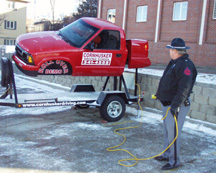 |
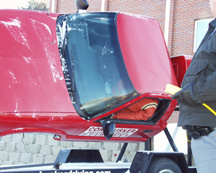 |
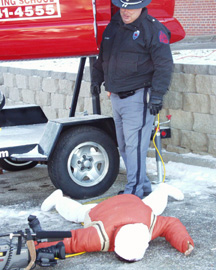 |
In the spring of 2002, four off duty police officers were in a rollover collision. The two back seat officers were thrown and killed. They were not buckled up. The two front seat officers were buckled and did not sustain serious injury. All four were following Nebraska state seat belt law.
In the fall of 2002, a group of Metropolitan Omaha community members met to discuss seat belt use to determine a plan of action. The group decided to form The Metro BELT Coalition (Buckle Everyone, Live Tomorrow).
Rollovers ‘”traumatic”
On Tuesday, coalition members met on campus and kicked off their meeting with a demonstration of the rollover crash simulator sponsored by the Cornhusker Driving School.
Nebraska State Patrol officer Randy Leader said the simulator can only reproduce a rollover crash at 11 to 30 miles per hours. Actual crashes often occur at 50, 60 and 70 miles per hour or more. “The scene of a rollover crash site is much more traumatic than even a head-on collision,” Leader said.
Seat belts provide the greatest protection against injury and death in the event of a collision. The National Highway Traffic Safety Administration (NHTSA) estimates that three out of five people killed in motor vehicle collisions would have survived had they been wearing their seat belts. In 2001, 75 percent of Nebraska motor vehicle fatalities were unbuckled. In 2002, 78 percent of Nebraska motor vehicle fatalities were unbuckled.
LB166 a “very positive step”
“The Metro BELT Coalition supports a standard seat belt law for all the occupants of a vehicle,” said UNMC’s Theresa Huber, injury prevention coordinator for the Omaha Trauma Center’s Injury Prevention Office, and a member of the coalition. “Right now there is a bill before the Nebraska legislature — LB166 — that will create a standard seat belt enforcement law for front seat occupants. We believe that all occupants — both front seat and back seat — should be required to buckle up, but LB166 is a very positive step in that direction.”
SAHP director touts seat belt usage
The coalition will work to decrease motor vehicle deaths and injuries by increasing seat belt use. This is a goal that will have the support of Pat Hageman, Ph.D., who nearly died in a car accident on Nov. 22, 1996.
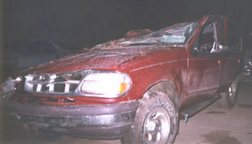 |
UNMC’s Pat Hageman credits her use of seat belts for saving her life in this 1996 crash. |
“As I drove over the first of two bridges on the Hwy 92 Platte River Bridge, my tires slid on a patch of ice and I tried desperately to get out of the oncoming lane,” said Hageman, director and professor of UNMC’s Physical Therapy Education, a division of the School of Allied Health Professions. “In attempting to regain control of my car, I did a 180-degree turn, then hit a support wire for an electricity pole. My SUV went airborne for 20 feet, then landed upside down in a 15-foot ditch between the two bridges. I was hanging upside down by my seat belt.
“I sustained serious spinal fractures in the cervical and thoracic regions that required extensive medical care and rehabilitation. My seat belt is the reason I am still here to tell this story. Whenever I see a picture of my vehicle with the roof flattened like a pancake, I get shivers up my spine. My seat belt was my life line.”
Saving lives, earnings
Preventing injuries and loss of life is not the only benefit from increased seat belt use — seat belts can save millions of dollars annually in lost earnings and medical expenses.
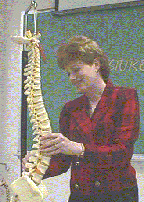 |
Pat Hageman |
If Nebraskans increased their seat belt use from about 70 percent to 85 percent, NHTSA conservatively estimates a savings of almost $50 million. This total includes saving $25,006,211 with the prevention of an estimated 30 deaths and $24,177,562 with an estimated prevention of 749 injuries.
In a study conducted by the Children’s Safety Network and the National Economics and Insurance Resource Center, the life economic cost to society for each fatality is more than $977,000. More than 80 percent of this amount is attributable to lost workplace and household productivity. Each critically injured survivor costs an average of $1.1 million. Medical costs and lost productivity accounted for 84 percent of the cost for the most serious level of injury.
Seat belt use and minorities
In addition, minorities are over represented in motor vehicle crashes. The leading cause of death for African American children is motor vehicle collisions. Motor vehicle collisions are the second leading cause of death for African Americans aged 15-26. Motor vehicle collisions are the leading cause of death for Hispanics through age 44 and the third leading cause of death for Hispanics of all ages.
 |
Theresa Huber |
“Seat belts are the best form of protection during a vehicle crash,” Huber said. “Now we just have to find the way to get everybody in the vehicle to buckle up.”
Coalition members
Other UNMC/NHS members of the coalition are: Peg Tidikis Mink, UNMC; Cheryl Bowles, UNMC, North Omaha Community Care Council; Aura Whitney Jackson, UNMC, South Omaha Community Care Council; and Kathy Warren, NHS.